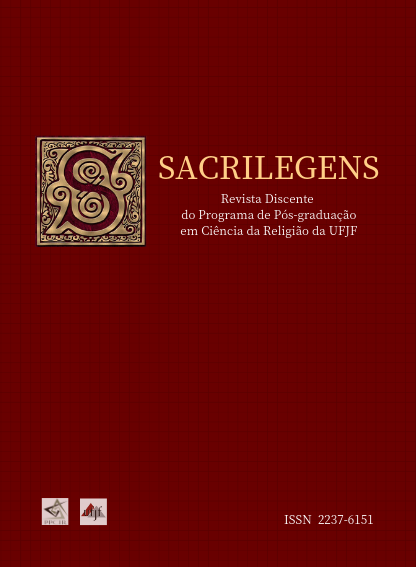The quarrel of spirits: the "do not know what" that escapes the numbers of "no religion"
Keywords:
self-identification, no-religion, religious experience, mobility subjectiveAbstract
The results released by the IBGE census of 2010 revealed that approximately fifteen million Brazilians declared themselves as "without religion". But what and whom would we be talking about exactly? What category would escape this census? For this population, does it become indifferent to require that life makes sense? Secularized consciousness or beliefs that escape adhesions? What is the imagery of "non-belief"? Necessary perspectives to a plural religious landscape, full of historical particularities, whose believes and belongings dialogue under the rhythm of subjective religious mobility. Under the bias of religious self-identification, there is a need for empirical research on the religious experience of subjects, on what weaves the religious happening, the "I do not know what" that the numbers do not reveal.
Downloads
References
ALMEIDA, Ronaldo de. Religião em Transição. Horizontes das Ciências Sociais no Brasil. Antropologia. São Paulo: ANPOCS, 2010.
BARROS, Manoel de. Memórias Inventadas. As infâncias de Manoel de Barros. São Paulo: Planeta do Brasil, 2010. p. 109
BAUMAN, Zigmunt. Identidade. Rio de Janeiro: Zahar, 2005.
______. O Mal-Estar da Pós-Modernidade. Rio de Janeiro: Zahar, 1998.
BENEDETTI, Luiz R. Pós-Modernidade: abordagem sociológica. In: Teologia na Pós- Modernidade. São Paulo: Paulinas, 2003.
BERGER, Peter L.; LUCKMANN, Thomas. Modernidade, Pluralismo e Crise de Sentido. A orientação do homem moderno. Petrópolis: Vozes, 2004.
______. O dossel sagrado. Elementos para uma teoria sociológica da religião. São Paulo: Paulus, 1985.
CAMURÇA, Marcelo Ayres. Entre sincretismos e “guerras santas”: dinâmicas e linhas de força do campo religioso brasileiro. Revista USP. São Paulo, n. 81, p. 173-185, março/maio 2009.
CARRANZA, Brenda. Catolicismo Midiático. Aparecida, São Paulo: Ideias & Letras, 2011.
CARVALHO, José Jorge de. Um espaço público encantado. Pluralidade Religiosa e Modernidade no Brasil. Disponível em: <http://nrserver34.net/~danunb/doc/Serie249empdf.pdf> Acesso em 30 mai 2012.
CHAMPION, Françoise. “La nébuleuse mystique-ésotérique” in CHAMPION ET HERVIEU-LEGER. De l’émotion en religion. Paris. Ed. Du Centurion, 1990, p. 17-69.
GUERRIERO, Silas, Novos Movimentos Religiosos: o quadro brasileiro. São Paulo: Paulinas, 2006.
HALL, Stuart. A identidade cultural na pós-modernidade. 11ª ed..Rio de Janeiro: DP&A, 2006.
HERVIEU-LÉGER, Danièle. O Peregrino e o Convertido. A religião em movimento. Petrópolis: Vozes, 2008.
INSTITUTO BRASILEIRO DE GEOGRAFIA E ESTATÍSTICA – IBGE. Censo Demográfico 2010. Características Gerais da População, Religião e Pessoas com Deficiência.
MAFFESOLI, Michel. O tempo das tribos. Rio de Janeiro: Forense Universitária, 2010.
MAGALHÃES, Antônio; PORTELLA, Rodrigo. Expressões do Sagrado. Aparecida, São Paulo: Santuário, 2008.
MARIZ, C.; MACHADO, M. das D. C. Mudanças recentes no campo religioso brasileiro. Antropolítica. Niterói, n. 5 (2º semestre) p. 21-43.
NEGRÃO, Lísias Nogueira. Nem “jardim encantado”, nem “clube dos intelectuais desencantados”. RBCS. Revista Brasileira de Ciências Sociais. Vol. 20, nº 59,
outubro/2005.Disponível em: < http://www.scielo.br/pdf/%0D/rbcsoc/v20n59/a02v2059.pdf> Acesso em 12 ago 2012.
OLIVEIRA, Pedro Ribeiro [entrevista]. Disponível em: < http://www.ihu.unisinos.br/entrevistas/511180-desafeicao-religiosa-esse-conceito-seriacentral-
para-entendermos-os-sem-religiao-entrevista-especial-com-pedro-ribeiro-deoliveira.
PIERUCCI, Antônio F. “Bye bye, Brasil” – O declínio das religiões tradicionais no Censo 2000. Estudos Avançados. São Paulo, 2004, n. 52. (set/Dez), p. 17-46.
Disponível em: < http://www.scielo.br/pdf/ea/v18n52/a03v1852.pdf > Acesso em 20 ago 2012.
RODRIGUES, Denise dos Santos. Religiosos sem Igreja: um mergulho na categoria censitária dos sem religião. Rever. Revista de Estudos da Religião. Dez/2007. p. 31-56.
Disponível em:<http://200.189.113.123/diaadia/diadia/arquivos/File/conteudo/artigos_teses/ENSINORELIGIOSO/artigos1/religiosos_sem_igreja.pdf>. Acesso em 20 jul 2012.
ROSA, João Guimarães. Grande Sertão. Veredas. São Paulo: Abril Culturas, 1983.
SANCHIS, Pierre. As religiões dos Brasileiros. Horizonte. Belo Horizonte, v. 1, n.2, p. 28-43, 2º sem. 1997. Disponível em: <http://periodicos.pucminas.br/index.php/horizonte/article/view/412/398. Acesso em 15 mai 2012.
SOARES, Edio. Le butinage religieux. Pratiques et pratiquants au Brésil. Suíça: Karthala, 2009.
Downloads
Published
How to Cite
Issue
Section
License
 Sacrilegens is licensed under a Creative Commons Attribution 4.0 International License.
Sacrilegens is licensed under a Creative Commons Attribution 4.0 International License.










